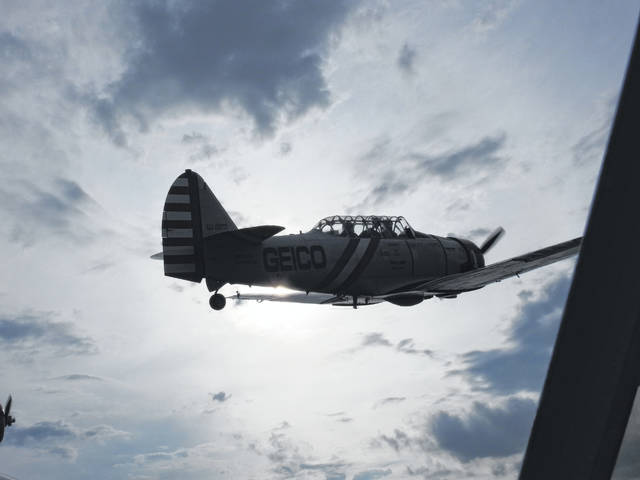
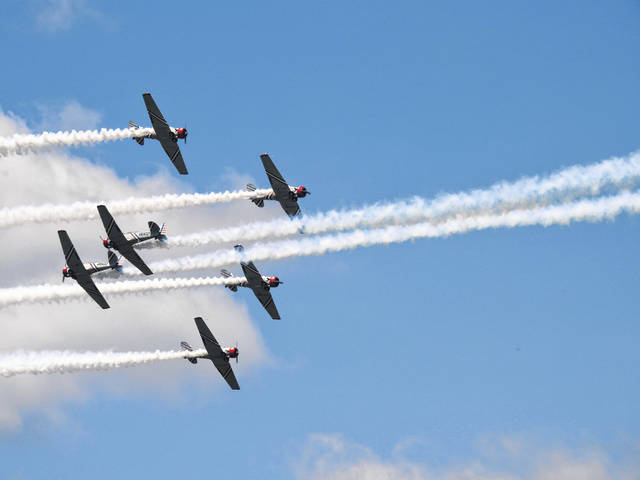
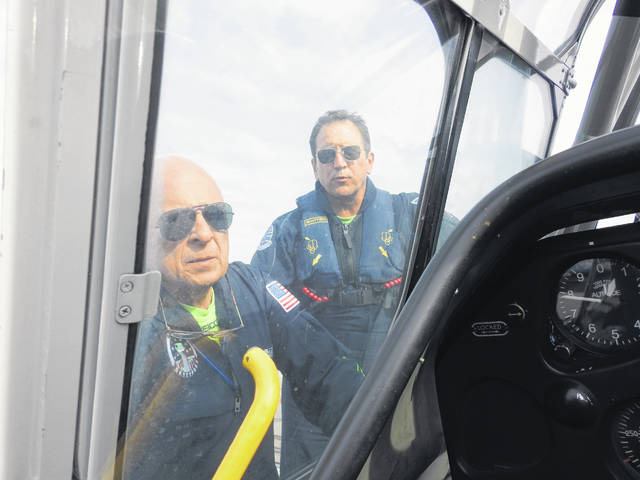
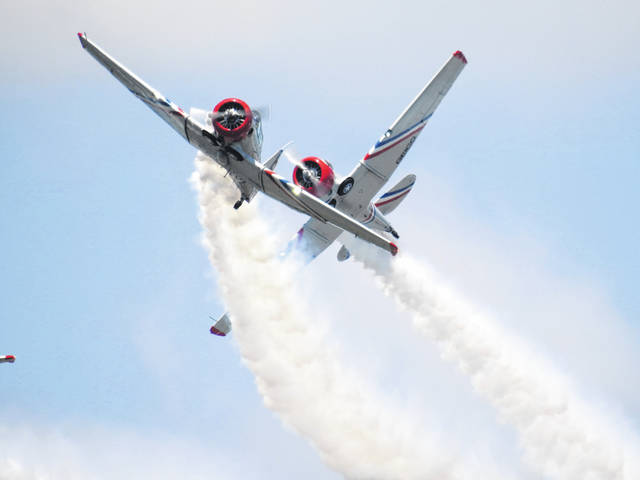
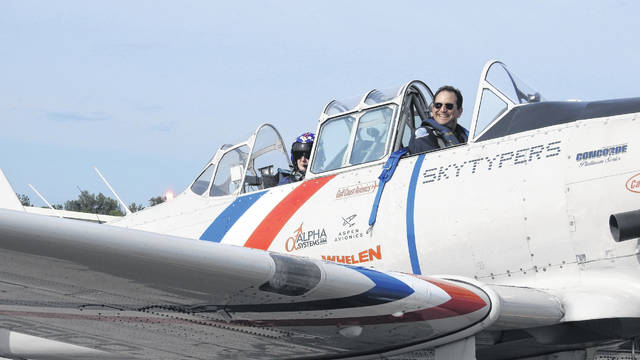
DAYTON — Flightsuit. Life vest. Parachute. Soviet looking skull cap. Helmet.
Life vest for a flight in Ohio? If there’s a puddle, I’ll find it. But, it can also help stabilize your neck if you’re getting ready to hit the trees. On the off chance you have to ditch the plane.
And what planes they are! The Geico Skytypers, a civilian squadron based in Long Island, fly the North American SNJ-2 (Navy variant of the T-6 Texan, built in 1940-1941). In World War II, these were the transition planes from the basic trainers to the tactical aircraft. Modified for skytyping missions, the 12 pilot team performs low level precision flying demos highlighting tactics and maneuvers taught to the military aviators, both from WWII and today, in an 18 minute impressive demo.
For the air show routine, the SNJ’s will fly approximately 250 feet apart to create letters 1,000 feet in the sky with messages spanning 6-8 miles in length. When asked if they’ve ever written anything saucy, or even “surrender Dorothy” the best we got was that messages were all up to the lead pilot, who is in control of a tablet that transmits radio signals to each of the other aircraft timed to precision, which will release the dot matrix puffs of (parafin solution) smoke. The messages can be seen for 15 miles in any direction.
My No. 3 Wing Pilot, Mark “Gooch” Gannucci entered Navy Flight training in 1988 and earned his Wings of Gold, then flew the F-14 Tomcat, and served in Bosnia aboard the USS Saratoga.
He and fellow pilot/Marketing Officer Steve Kapur took wonderful care preparing me for the media ride over the Dayton Vectren Air Show parade. (Spoiler alert, I did not hear “bail out bail out bail out” and thankfully had no need for the life vest or parachute.) Needless to say though, I was far too excited to care about a parade as I gleefully tagged along in a North American Aviation built beast. Along with Lead/Opposing Solo pilot Tom Daly who prepped us in the trailer- all three men did their best to make sure the rest of us had fun with their vintage aircraft. Could I see alright? Did I need sunglasses? Because the helmet had built in shades. They collectively agreed that I looked more bad*** with the helmet visor down (let’s be honest, I have a face for radio if you know what I mean).
Prep work done, we taxied toward the runway, sliding past two F-18’s and the Thunderbirds F-16’s. We outranked them for vintage coolness. Takeoff was so smooth as to be a dream, and Mark was polite enough to check over the intercom to make sure I was okay. I made sure to never, never hit the hot mike, lest I share with the class my hoots of delight. I didn’t notice if we left a message in the air because I was too transfixed at how close we were in formation; I throw like a girl, but pretty sure I could’ve lobbed a tennis ball into #4’s lap (if I were so coordinated, which I’m not, and promise never to do. Please let me ride again).
Back on the ground, Mark shared that in January, the team assembled for a two day ground school then spent a week in Florida where they practiced their routine and other specialized maneuvers three times a day. “By the end of the week, we’ve done the routine 12-15 times. We really beat the heck out of each other,” Mark admits with a nod, “and got all the mistakes out.”
If something came up, could he sub with another team-say, the Heritage Flight? “Yes and no,” he explains. “Theoretically, formation is formation, whether it’s Navy, Air Force, Marine, we’re all trained in the same tactics; you saw many of them performed today.” [No I didn’t; I was oogling the other planes, my bad] “Basic echelon entrail, diamonds, breaks, line abreast, rendevous, the way we pitch and maintain position. You saw it all; that was 90 percent of what fighter pilots learn.” [Now I feel even worse for behaving like a slack jawed idiot up there] “You can do a million things with those basic types of maneuvers. So yes, we can ‘plug and play’, but we don’t know their routine. But as far as joining up and being safe, absolutely we could do that.”
How close to they fly with each other? “Actually, our wingtips overswseep a little bit. We have a good drop down of about three feet and we all have an out if something happens if we need to escape each other. “
What’s the best thing about his first year of being a Skytyper? “Interacting with the public. In the Navy I was out to sea on an aircraft carrier, trying not to go to war, but out here, we get to bring this type of flying to the public. Everyone’s out here waving flags, it’s a great time.”
Regarding their planes, “There was never a better age in aviation than the 30’s and 40’s where all these airplanes and technologies kept leaping over each other. Where you could hide behind a cloud and sneak around; that’s what we all dream of. Nowadays,” he flails his arms for emphasis, “it’s all technology, and with drones, the pilot is being further separated from the profession, so it gives us a sense of …you know, we have to be good, we have to trust each other and have faith in each other to form a good routine.”
F-14 Tomcat vs. the vintage trainer that we all love- “The F-14 is much easier to fly, ‘cause these WWII planes have an 8 foot propeller and there’s a lot of gyroscopic effects with that . Any time you move the nose or you change power, the airplane yaws and you’re always consciously/subconsciously moving your feet on the rudder pedals as you’re adjusting and changing air speed. It’s a lot more complex as far as stick and rudder skills. The tailwheel aircraft are a little more challenging to fly.”
When we were taxing home, I asked about what was in a hanger; I saw the L-39 and the Sea Harrier (both owned by Art Nalls). But what was tucked into the right corner? “That,” he answered with a smile, “was the FM2 Wildcat, the plane that won the Battle of Midway, my favorite Navy fighter.”
How is the maintenance on an almost 80 year old aircraft? “We have three full time mechanics. We’ve got the latest technology installed in these aircraft. These airplanes were overbuilt; they were trainers. These were designed to take kids that were 17, 18 years old and train them to go fly and fight a war. We trust these airplanes implicitly, they’re very strong.”
The SNJ’s are uniquely suitable for skytyping because they can hold a 70 gallon oil tank in the back, and can put out about 40 messages with a huge tank like that. It has the lift and power to stay up in the air for about four hours, or until the oil runs out.
What had me taken aback and I feel like I need to protest this; are you familiar with the Geico Skytyper commercial, with the gecko in the back? The pilot was one of them, but turns out an actor was used as a voice over.
“I’m livin’ the dream, to be able to do this,” Mark admitted with a little shake of his head. How many people get to say that? “It’s wonderful, doing this…like I said, the public, it’s…it’s just wonderful to get to meet so many great people, kids especially. This is a great opportunity.”
Having abused Mark long enough, we segued over to pilots #1 Larry Arken and #2 Chris Thomas.
“This is a great big team that comes together,” Chris enthused. “We all enjoy being together,” and Larry inserted, “We have a lot of laughs. We pick on each other, we tease each other, we have a lot of good times.” They bounced back and forth, telling us how they do a lot of events, and especially enjoy visiting with Make A Wish and military veterans. They enjoy connecting with people, and brining joy to their faces. Larry insisted it’s even fun to meet the media; God bless him.
What will be some great memories from their time as Skytypers? They shared how amazing it was to fly around the Statue of Liberty for the D-Day commemoration with a C-47 a few weeks ago. Then Chris got choked up telling us about last year and Make A Wish. “There was a young kid in a wheelchair; they usually get up on the wing and look in the cockpit. Well, he was the one who couldn’t stand. I picked him up, carried him over, turned around -and I’ll start boo hooin’ in a minute-and ah..yeah…” he turned away for a moment, swiped his eyes while Larry’s eyes crinkled in a smile. Chris eventually continued; “I turned around and his mom and grandma were just balling. His mom and dad are crying, and they said he never lets anyone near him, he never lets anyone hold him.” Larry interjected, “That’s the good stuff, that’s the fun stuff.”
What’s the charm of the T-6? It trained thousands of aviators, the greatest generation, to go out and win a war. What’s the charm of the Geiko Skytypers? A fantastic bunch of guys. Truly.






